![]()
![]()
![]()
Use LEFT and RIGHT arrow keys to navigate between flashcards;
Use UP and DOWN arrow keys to flip the card;
H to show hint;
A reads text to speech;
21 Cards in this Set
- Front
- Back
|
What is refraction? |
Refraction is the change of direction of light as it passes from one medium (substance) to another.
The two media must have different densities, such as air and glass. |
|
|
When light passes into a denser medium, it speeds up.
True or False? |
False - When light passes into a denser medium, it slows down.
|
|
|
What is meant by the term 'the normal'? |
The normal is a dotted line drawn perpendicular to the surface of the refracting material, at the point of entry of the light.
|
|
|
Explain how light refracts with respect to the normal when it travels: (a) from air to a denser material. (b) from a denser material into air. |
(a) When light travels from air into a denser medium like water or glass, it will refract towards the normal. (b) When light travels from a denser medium into air, it will refract away from the normal. |
|
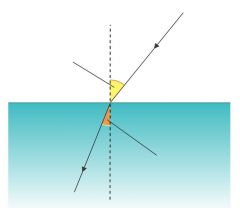
Label the diagram. |
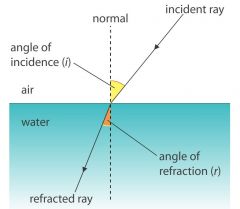
|
|
|
What is the refractive index? |
The degree to which a material slows the speed of light (compared to its speed in a vacuum) is its refractive index. |
|
|
What is the equation used to calculate the refractive index? |
refractive index = sin i ÷sin r i is the angle of incidence r is the angle of refraction |
|
|
A beam of light hits a glass block. The angle of incidence angle of incidence is 55°. The angle of refraction inside the block is 33°. Calculate the refractive index. |
Work out the sine of angle i sin 55 = 0.819 Work out the sine of angle r sin 33 = 0.545 refractive index = sin i ÷ sin r refractive index = 0.819 ÷ 0.545 = 1.50 |
|
|
What is a Lens? |
A lens is a transparent block that causes light to refract to form an image. |
|
|
What is a convex or converging lens? What is the symbol for a converging lens? |

A convex or converging lens is curved outwards on both sides. (thicker in the middle)
|
|
|
Explain with the use of a diagram what the terms 'principal focus' and 'focal length' are in a converging lens? |
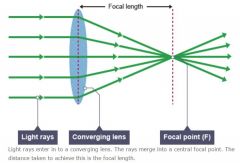
Rays from a single point on a distant object arrive at the lens parallel to one another.
Converging lenses refract these parallel rays so that they are come together at a point called the principal focus (labelled F on a diagram). |
|
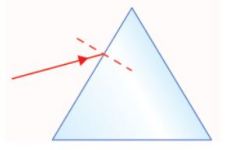
The figure shows a prism with a ray of red light shining at it.
Copy the diagram and complete it to show the path of the light through the prism. You do not need to calculate the angles, just show the approximate direction in which the light will travel. |
Correctly drawn diagram, with normals drawn at both faces. The exact angles are not important, as long as r is less than i where the light enters the prism, and r is greater than i where it leaves. |
|
|
A ray of light shines into a glass block along the normal. What is the angle of refraction? |
0°. |
|
|
The angle of incidence of a ray of light passing from air into water is 30°. The angle of refraction is 22°. What is the refractive index of water? |
Refractive index = sin i/sin r = sin(30) ÷ sin(22) = 0.5 ÷ 0.375 = 1.33. |
|
|
A ray of light shines into a glass block at an angle of incidence of 55°. What is the angle of refraction if the refractive index of glass is 1.5? |
sin r = sin i ÷ refractive index = sin(55) ÷ 1.5 = 0.546 r = 33.1° |
|
|
Light passing through a glass block leaves the block with an angle of refraction of 25°. What was the angle of incidence at the glass/air interface if the refractive index of glass is 1.5? |
sin i = sin r × refractive index
= sin(25) × 0.67 = 0.283 i = 16.4° |
|
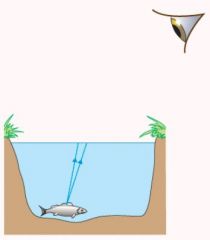
(a) Copy the diagram and complete the rays of light coming from the fish to show how they bend when they leave the water. (b) Show on your diagram where these rays of light would appear to be coming from to the observer, and where the fish would appear to be. |
(a) Rays bend to right as they leave the water, not continue in straight line. (b) ‘Virtual’ fish appears above real fish, as if light rays were going straight from it to eye (not bending in water). |
|
|
Explain why objects in water usually appear to be closer to the surface than they really are. |
Light reflected from the object is bent away from the normal when it leaves the water. Our eyes/brain assume that light travels in straight lines, so the object appears to be at a shallower depth than it really is. |
|
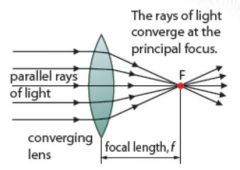
(a) State whether a thick or a thin convex lens would have the shortest focal length if they were both made from the same material.
(b) Explain your answer,using a sketch similar to the figure to help you. |
Light has to be bent to reach a focal point. The thicker the lens, the more curved its surfaces are and so the more it bends light. A thicker lens will therefore have a shorter focal length than a thin one. |
|
|
Explain what ‘refractive index’ is, and why a lens with a certain focal length can be thinner if it is made of a material with a higher refractive index. |
The refractive index is a way of describing how much light bends when it passes from one medium into another. The higher the refractive index, the more light is bent when it goes into that medium from air. A lens bends light t to bring it to a point at the principal focus. The amount of bending depends on how thick/curved the lens is and on the refractive index. The same focal length can be achieved if a lens is made thinner but of a material with a higher refractive index. |
|
|
What are the key points to remember? |
Light changes direction when it passes at an angle other than 90° from one transparent medium to another. This is called refraction. The amount of bending depends on the refractive index of the medium. refractive index = sin(i) ÷ sin(r) Convex lenses are thicker in the middle than at the edges. Convex lenses make rays of light converge to a point. The point to which parallel rays of light converge is the principal focus of the lens. The distance from the centre-line of the lens to the principal focus is the focal length of the lens. |

